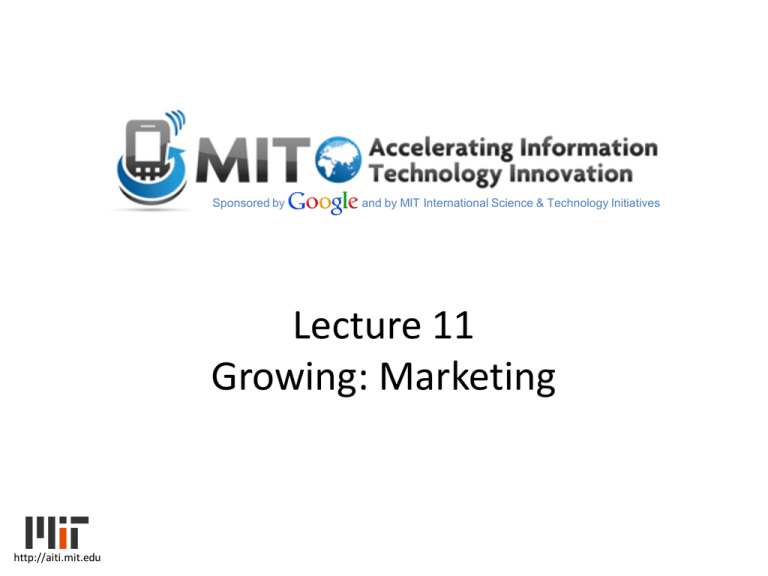Lecture 11 Growing: Marketing
advertisement

Sponsored by and by MIT International Science & Technology Initiatives Lecture 11 Growing: Marketing http://aiti.mit.edu CURRICULUM Hackathon #1 Hackathon #2 Baguio Networking Event Context, techniques, and idea generation Week 1 Week 2 Executive summary, early adoption testing Week 3 Programming tools, Mobile Web, Django, SMS and backend Google App Engine http://aiti.mit.edu Week 4 Week 5 Android and UI design Project Showcase Growing, financing, and demo Week 6 Week 7 Discretion of Instructors (based on class projects) 2 SCHEDULE FOR TODAY Time Topic 4:10PM Marketing 4:35PM Checking Prototypes 5:20PM Break 6:00-9PM Guest: Anne-Michelle Santos from Globe (Labs) http://aiti.mit.edu 3 Two years from now, you’ll have built the perfect product for your customers… Do you really think word of mouth will be enough? How long will it take for your competitors to build a product half as good Answer: 1 year (at most) What if they promote it 100 times more than you? You might want to invest some time thinking about marketing… Early. http://aiti.mit.edu 4 MARKETING VERSUS SALES Marketing Sales Comes first Goal: generating leads Comes second Goal: converting leads into dollars Methods: • Design the right product • Find the right price • Promote the product • Place it in the right channel (placement) • Advertise the product to get sales • Manage the brand • Conduct market research Methods: • Close the sale • Build relationship with customers • Support the product (customer satisfaction) • Help marketing do its job by providing insights (primary research) • Hire a sales force and send them to the customers Notes: Marketing can be quantitative and can be done effectively using scientific approach in mature industries. Cutting edge of marketing however flows with trends and culture Notes: Sales is up close and personal. A sales person success can be highly dependent on their “network”. In some companies, the best sales people make more money than the company CEO. http://aiti.mit.edu 5 SALES BASIC DICTIONARY Keyword Definition Direct sales Sales process involving person to person contact (e.g. door to door). Ex: you buy a MacBook Pro Retina at the Apple store Indirect sales Sales process involving a third party agent doing the sale on behalf of the product company (e.g. telemarketing). Ex: you buy a Samsung Galaxy SIII from the telecom company. Cross-sale In companies with multiple product lines or divisions, it is the practice of selling an existing customer a product from another line or division. Ex: selling toner cartridge to customers of HP printers. Business-to-business (B2B) Sales process involving one business to another, often accompanied by a contract specifying a “service-level-agreement”. Ex: SAP sales a inventory management software to Dole Company. Business-to-consumer (B2C) Sales process involving one business to directly to consumers. Ex: Grocery store selling bread or Rovio selling Angry Birds Space Customer-relationshipmanagement (CRM) A model associated with a software for managing a company's interactions with customers, clients, and sales prospects. Ex: salesforce.com http://aiti.mit.edu 6 MARKETING BASIC DICTIONARY Keyword Definition Market research Primary research: involves the conduction and compilation of research directly in the field (e.g. talking to customers, prospects, and competitors) – expensive but high quality / relevance of insights Secondary research: conducted using existing data from external sources (e.g. desk research) – cheap but sometimes answers are not readily available Market dominance Relative strength of a producer in an industry and behavior adopted as a result: leader, challenger, follower, nicher. Content marketing Creation and sharing of content in order to attract, acquire and engage clearly defined and understood current and potential consumer bases with the objective of driving profitable customer action Marketing communications Umbrella term including advertising, branding, graphic design, packaging, public relations and more. Social media marketing Process of gaining website traffic or attention through social media sites (Twitter, Facebook, Blogs, YouTube) Search engine marketing Promotion of websites (or products and services) by increasing their visibility in search engine results pages through advertising (paid placements, contextual advertising, and paid inclusions) as well as optimization (both on-page and off-page) Search engine optimization http://aiti.mit.edu 7 MARKETING PLAN Outline of a company’s overall marketing effort 1. 2. 3. 4. 5. 6. Don’t waste your precious time coming up with a detailed plan. Early on, for every minute you spend on your marketing plan you should spend ten talking to your customers. But as you talk to your customers (or observe their behaviors on your site) ask yourself those questions… Price — The amount of money needed to buy products Product — The actual product Promotion (advertising)- Getting the product known Placement — Where the product is sold People — Represent the business Physical environment — The ambiance, mood, or tone of the environment 7. Process — The Value-added services that differentiate the product from the competition (e.g. after-sales service, warranties) 8. Packaging — How the product will be protected http://aiti.mit.edu 8 CONTENT MARKETING Content marketing products frequently take the form of • In-person: roadshows, roundtables, events • Live: interactive online, social media • Print or online newsletters and emails • Webcasts/webinars, podcasts, video portals or series • Digital content: websites, microsites, blogs • Custom magazines • White papers “Sharing content as a means of persuading decision-making” http://aiti.mit.edu 9 SEARCH ENGINE OPTIMIZATION (SEO) • Improving/promoting a website to increase number of visitors from search engines (SE) • Grasp the average searcher, and specifically your target audience – get the RIGHT type of visitors “Do” Transactional, “Know’ Informational, or “Go” Navigational Queries Searches are growing strong at nearly 20% a year • • http://aiti.mit.edu 10 BEWARE OF SE LIMITATIONS Spidering and Indexing Problems • Errors in a websites crawling directives can lead to blocking SE entirely • Interpreting non-text content Content to Query Matching • Text not written in common terms (i.e. food cooling units vs. refrigerators) • Language subtleties ( color vs. colour) • KEYWORDS – use naturally and strategically The Tree Falls in a Forest • It is also about MARKETING • People must come to your site to popularize it http://aiti.mit.edu 11 HOW DO I COMPETE? Head: 2.5 cm Tail: 355 km http://www.seomoz.org/blog/illustrating-the-long-tail http://aiti.mit.edu 12 DELIVERING CUSTOMER VALUE Benefiting your customers • Are they saving money/time? • Are they making more money? • What other benefit are you bring them? Alternatives to your customers • How are distinguishing yourself from competition Product (or service) • Basic products (i.e. tangible) • Intangible http://aiti.mit.edu 13 EXAMPLE: INTANGIBLE SERVICE What is the customer value? • Compiling information about available flight connections and fares • Allowing the customer to buy a ticket • Forwarding billing information to the airline • Forwarding reservation information to the customer http://aiti.mit.edu 14 MANAGING THE BRAND 84% of 25-to-34 year olds have left a favorite website because of an “irrelevant or intrusive ad” http://aiti.mit.edu 15 DEFINING THE PRODUCT • Customers NEEDS vs. WANTS • Marketers try to shape the wants because many customers do not know what they want when the product, concept, or service is new • Example: chocolates and flower for special occasions • Game plan for long term http://aiti.mit.edu 16 HOW TO BEAT YOUR COMPETITORS: MARKET RESEARCH • Fill the niche market • Identify and analyze market need and trends • Spot weakness in existing competitors • Make yourself stronger by noticing trends http://aiti.mit.edu 17 NEXT CLASS: FINANCE AND… Those not pitching next class will build a simple but thorough financial model (template posted on aiti.mit.edu) http://aiti.mit.edu 18 …PITCHING! We will give each team 1 minute to explain their idea to the class, and 2 minutes of Q&A from the class You will assign 1-2 team members to pitch the idea to the rest of the class http://aiti.mit.edu 19 PITCHING TIPS Delivery a. Make sure everyone can hear you b. Talk slowly and enunciate – the audience should understand you c. Practice, practice, practice Content (topics that investors want to hear) a. What problem are you trying to solve? (Make it real, small and simple: “My neighbor Jun owns a store and …”) b. What solution are you proposing to this problem? (Give us specific examples, refer to other solutions/software your audience might be familiar with but explain how you differ) c. Why is your team able to implement this solution better than others? (Give us specific skills and experience that you have) d. Once you’ve solved this problem, what will you do next? (Make us dream of what your company could become, talk about market size) http://aiti.mit.edu 20








